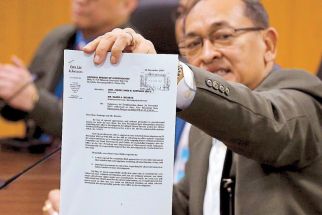Wannabe Jollibee
April 22, 2002 | 12:00am
By 2020, Jollibee Foods Corp. intends to be a global brand. It currently has 25 stores outside the Philippines, eight of which are in the United States.
"All our stores are in California," said Jollibee vice-president for finance Miguel Jose Navarrete. "The California market is so big that it accounts for about 15% of the US sales of the largest food service chain in the world."
The US business is handled by FSC Food Corp., which is now 100% owned by Jollibee after completely buying out the shares of its original partner, former Finance Secretary Edgardo Espiritu.
"Although we initially expanded overseas in 1986 through franchising, we are now committed to developing a critical mass of company-owned stores which will become the benchmark against future franchise operations. With a successful track record, it will become easier to sell the franchise," said Navarrete.
Aside from the US, Jollibee also wholly owns all the stores in Hong Kong through Jollibee HK Ltd. and partially owns the Brunei operations through a joint venture company called Entrek. It has master franchisees in the Middle East, Southeast Asia and the Pacific islands.
Just like the Philippines, where it is the acknowledged leader in the food service industry, Jollibee’s overseas business is driven by quality food. Tony Tan Caktiong, who incorporated Jollibee in 1978 with his brothers and remains the company’s president and chief executive officer, likes to describe it as "great taste and happiness to everyone".
Tan’s definition of happiness (or the pleasant experience that translates to repeat business) is, however, different from most successful food service chains in the world. While other chains equate the pleasant experience with familiarity that comes from the same food served across all stores, Jollibee believes the consumer’s pleasant experience comes from food that taste good but may differ from culture to culture.
"We have no undying desire to keep the taste the same here in the Philippines and in our operations abroad. For us, the important thing is to find the winning taste profile for each of the markets that we operate in. To do that, we listen very closely to what our customers want and we give them what they want," Navarrete said.
For example, Chicken Joy, which account for 35% to 40% of the company’s product mix, has evolved since its introduction in 1980. In a series of calibrated re-inventions, Chicken Joy today has the crunchy skin (like chicharon or deep-fried pork rind) that Filipinos like.
Jollibee’s willingness to innovate and listen to its customer was one of the major factors cited by Far Eastern Economic Review when its annual survey placed Jollibee as the top Philippine company for the last four years. It also topped the survey of the local compnies that others try to emulate.
Last year, Asian Business magazine cited Jollibee as the most admired company in the country in large part because of its growth potential or ability to expand quickly. At the core of Jollibee’s growth–850 stores systemside, including Chowling, Greenwich and Delifrance–is the franchising system.
"Because of franchising, our expansion was not limited by the lack of capital. We used other people’s money. Our expansion was also not limited by a small management team. We used the entrepreneurial skills of others who wanted a chance to be part of our success story," said Navarrete.
To date, 60% of Jollibee’s stores are held by franchisees.
Aside from great taste, the other half of Jollibee’s success is its reasonable price. The company has meals that retail from P29 upward. "We have P80 meals that sell–and sell well–because it tastes good (sarap) and they get good value (sulit)," said Navarrete.
Despite the rise in the cost of raw materials, the last price hike implemented by Jollibee was made in August, 2001. The 2% price hike somewhat offset the weaker peso.
Systemwide, Jollibee generated sales of P24.1 billion last year, an 18.8% increase from 2000. "We were originally tracking 20% but we had to reduce our target because of the weak local market," said Navarrete. Of that total, the foreign operation accounted for 3% of gross revenues.
This year, the company projects a sales growth of between 10% to 15% as it consolidates its primary market, the children and their power to pester their parents, and develops the upscale market with products such as the Champ and Chicken Joy. "The A market will never replace our main B-C-D market but the aspirational message that the A market sends to our core market is something we want to develop. There’s also the opportunity for better margins in coming up with products for this market," said Navarrete.
Capital expenditures for this year, however, is higher at between P1.3 billion and P1.4 billion compared to last year’s P1 billion. The bulk of the money will go to completing the huge commissary being built in Canlubang. "Our current commissary in Pasig will serve as back up to Canlubang, which will have bigger and more modern machines," said Navarrete.
One product which will continue to be imported to the US will be the peach mango pie in large part because it costs less to buy imported peaches than to export mangoes in sufficient quantities in the US.
That such a commissary goes hand-in-hand with co-branding opportunities is another story. – MJ Grey
"All our stores are in California," said Jollibee vice-president for finance Miguel Jose Navarrete. "The California market is so big that it accounts for about 15% of the US sales of the largest food service chain in the world."
The US business is handled by FSC Food Corp., which is now 100% owned by Jollibee after completely buying out the shares of its original partner, former Finance Secretary Edgardo Espiritu.
"Although we initially expanded overseas in 1986 through franchising, we are now committed to developing a critical mass of company-owned stores which will become the benchmark against future franchise operations. With a successful track record, it will become easier to sell the franchise," said Navarrete.
Aside from the US, Jollibee also wholly owns all the stores in Hong Kong through Jollibee HK Ltd. and partially owns the Brunei operations through a joint venture company called Entrek. It has master franchisees in the Middle East, Southeast Asia and the Pacific islands.
Tan’s definition of happiness (or the pleasant experience that translates to repeat business) is, however, different from most successful food service chains in the world. While other chains equate the pleasant experience with familiarity that comes from the same food served across all stores, Jollibee believes the consumer’s pleasant experience comes from food that taste good but may differ from culture to culture.
"We have no undying desire to keep the taste the same here in the Philippines and in our operations abroad. For us, the important thing is to find the winning taste profile for each of the markets that we operate in. To do that, we listen very closely to what our customers want and we give them what they want," Navarrete said.
For example, Chicken Joy, which account for 35% to 40% of the company’s product mix, has evolved since its introduction in 1980. In a series of calibrated re-inventions, Chicken Joy today has the crunchy skin (like chicharon or deep-fried pork rind) that Filipinos like.
Last year, Asian Business magazine cited Jollibee as the most admired company in the country in large part because of its growth potential or ability to expand quickly. At the core of Jollibee’s growth–850 stores systemside, including Chowling, Greenwich and Delifrance–is the franchising system.
"Because of franchising, our expansion was not limited by the lack of capital. We used other people’s money. Our expansion was also not limited by a small management team. We used the entrepreneurial skills of others who wanted a chance to be part of our success story," said Navarrete.
To date, 60% of Jollibee’s stores are held by franchisees.
Despite the rise in the cost of raw materials, the last price hike implemented by Jollibee was made in August, 2001. The 2% price hike somewhat offset the weaker peso.
Systemwide, Jollibee generated sales of P24.1 billion last year, an 18.8% increase from 2000. "We were originally tracking 20% but we had to reduce our target because of the weak local market," said Navarrete. Of that total, the foreign operation accounted for 3% of gross revenues.
This year, the company projects a sales growth of between 10% to 15% as it consolidates its primary market, the children and their power to pester their parents, and develops the upscale market with products such as the Champ and Chicken Joy. "The A market will never replace our main B-C-D market but the aspirational message that the A market sends to our core market is something we want to develop. There’s also the opportunity for better margins in coming up with products for this market," said Navarrete.
Capital expenditures for this year, however, is higher at between P1.3 billion and P1.4 billion compared to last year’s P1 billion. The bulk of the money will go to completing the huge commissary being built in Canlubang. "Our current commissary in Pasig will serve as back up to Canlubang, which will have bigger and more modern machines," said Navarrete.
One product which will continue to be imported to the US will be the peach mango pie in large part because it costs less to buy imported peaches than to export mangoes in sufficient quantities in the US.
That such a commissary goes hand-in-hand with co-branding opportunities is another story. – MJ Grey
BrandSpace Articles
<
>
- Latest
Latest
Latest
October 16, 2024 - 4:00pm
By Aian Guanzon | October 16, 2024 - 4:00pm
October 1, 2024 - 9:00am
October 1, 2024 - 9:00am
September 27, 2024 - 4:00pm
September 27, 2024 - 4:00pm
September 12, 2024 - 2:10pm
September 12, 2024 - 2:10pm
Recommended






























